Taxation Law Report: Case Studies on Taxation Issues and Rulings
VerifiedAdded on 2020/04/07
|12
|2240
|33
Report
AI Summary
This report provides a comprehensive analysis of various taxation law cases, addressing issues related to capital gains, fringe benefits tax (FBT), rental properties, tax avoidance, and the sale of timber. The report delves into specific scenarios, such as the acquisition of an antique vase, the implications of interest refunds from a banking corporation, the allocation of losses in co-owned rental properties, and the legal principles of tax avoidance. Each case is examined in detail, referencing relevant taxation rulings and legislation, including the Income Tax Assessment Act 1936 and associated regulations. The report offers concluding remarks for each case, summarizing the key findings and their implications for tax liability and compliance, providing a clear understanding of complex tax scenarios.
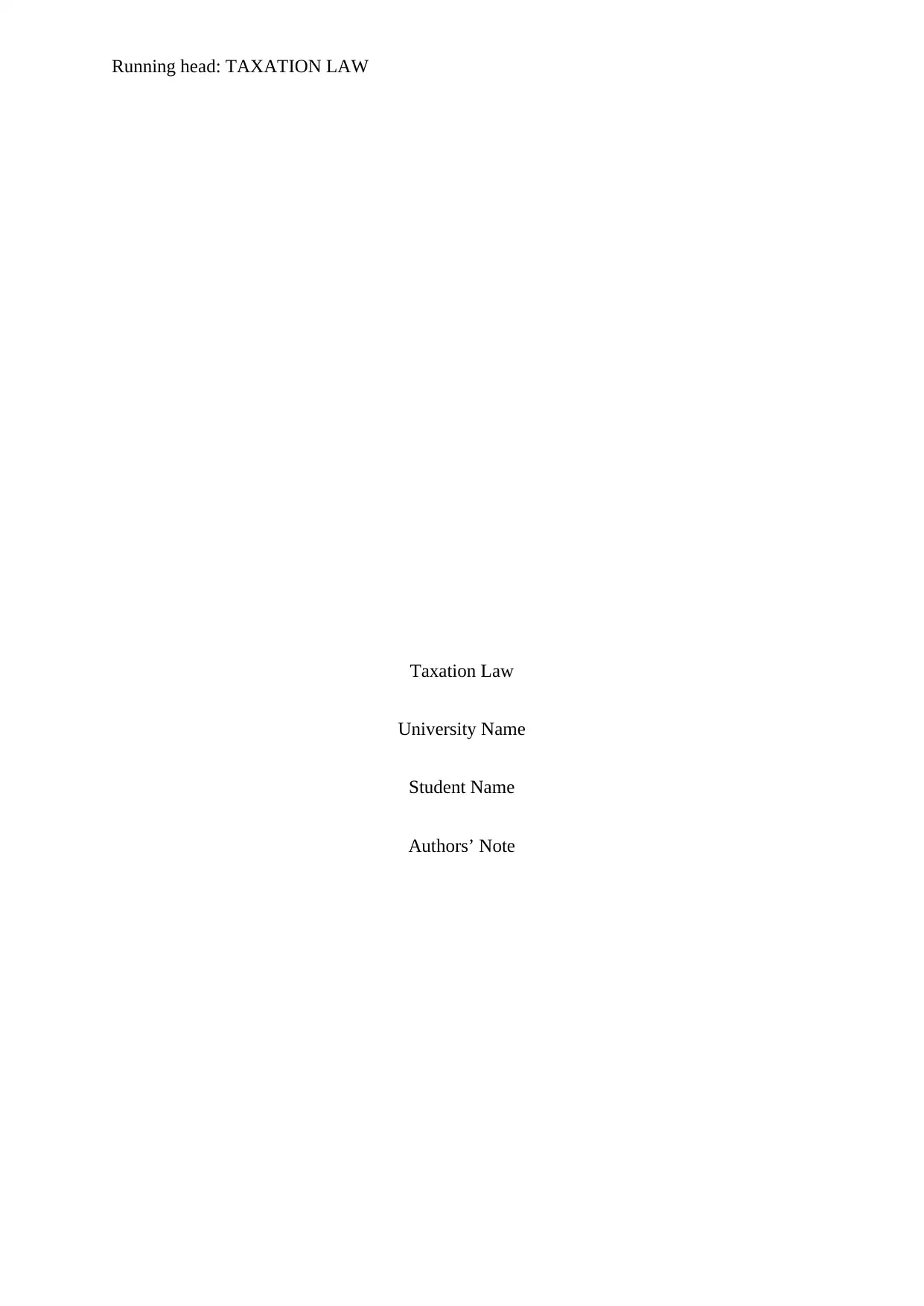
Running head: TAXATION LAW
Taxation Law
University Name
Student Name
Authors’ Note
Taxation Law
University Name
Student Name
Authors’ Note
Paraphrase This Document
Need a fresh take? Get an instant paraphrase of this document with our AI Paraphraser
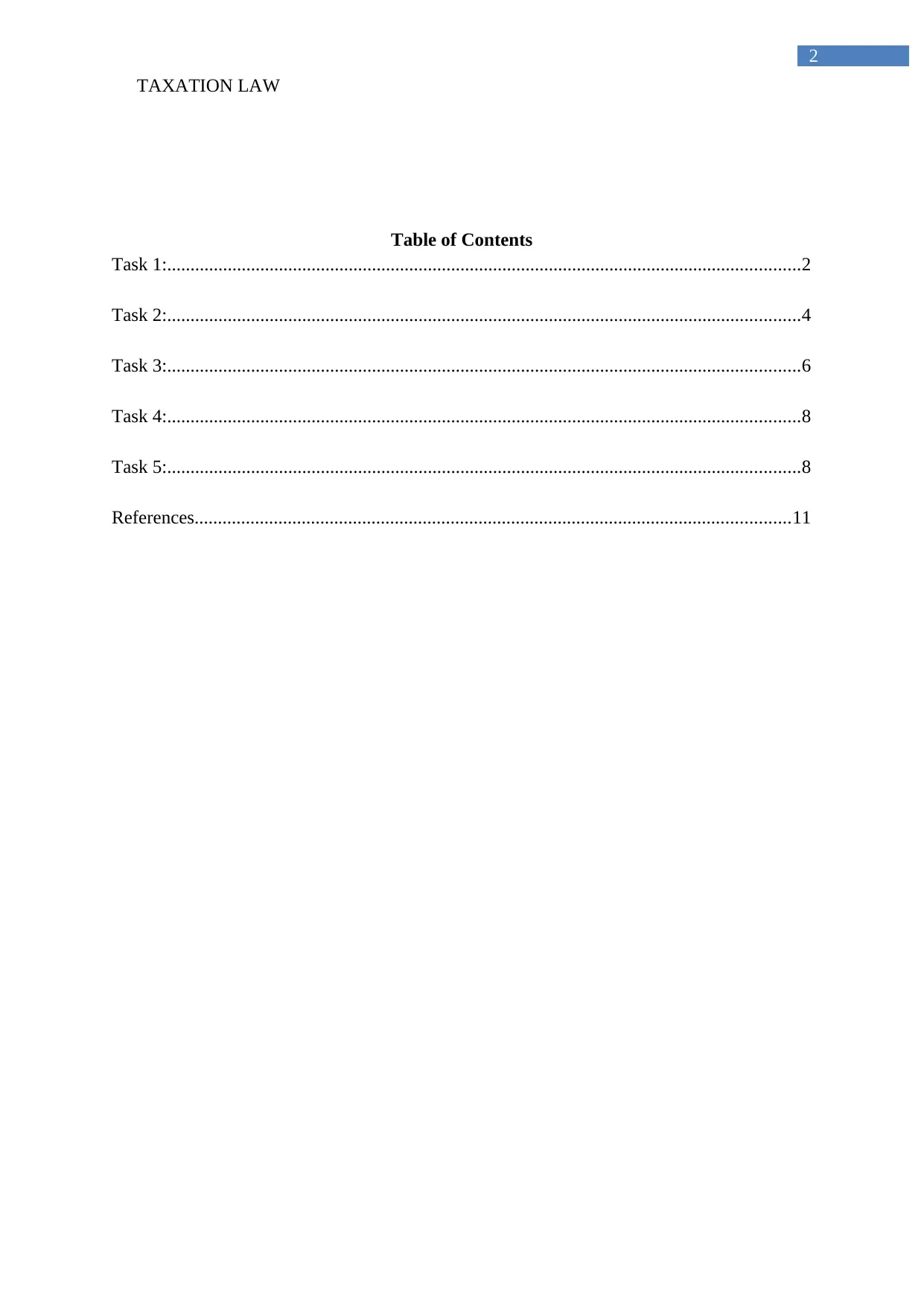
2
TAXATION LAW
Table of Contents
Task 1:........................................................................................................................................2
Task 2:........................................................................................................................................4
Task 3:........................................................................................................................................6
Task 4:........................................................................................................................................8
Task 5:........................................................................................................................................8
References................................................................................................................................11
TAXATION LAW
Table of Contents
Task 1:........................................................................................................................................2
Task 2:........................................................................................................................................4
Task 3:........................................................................................................................................6
Task 4:........................................................................................................................................8
Task 5:........................................................................................................................................8
References................................................................................................................................11
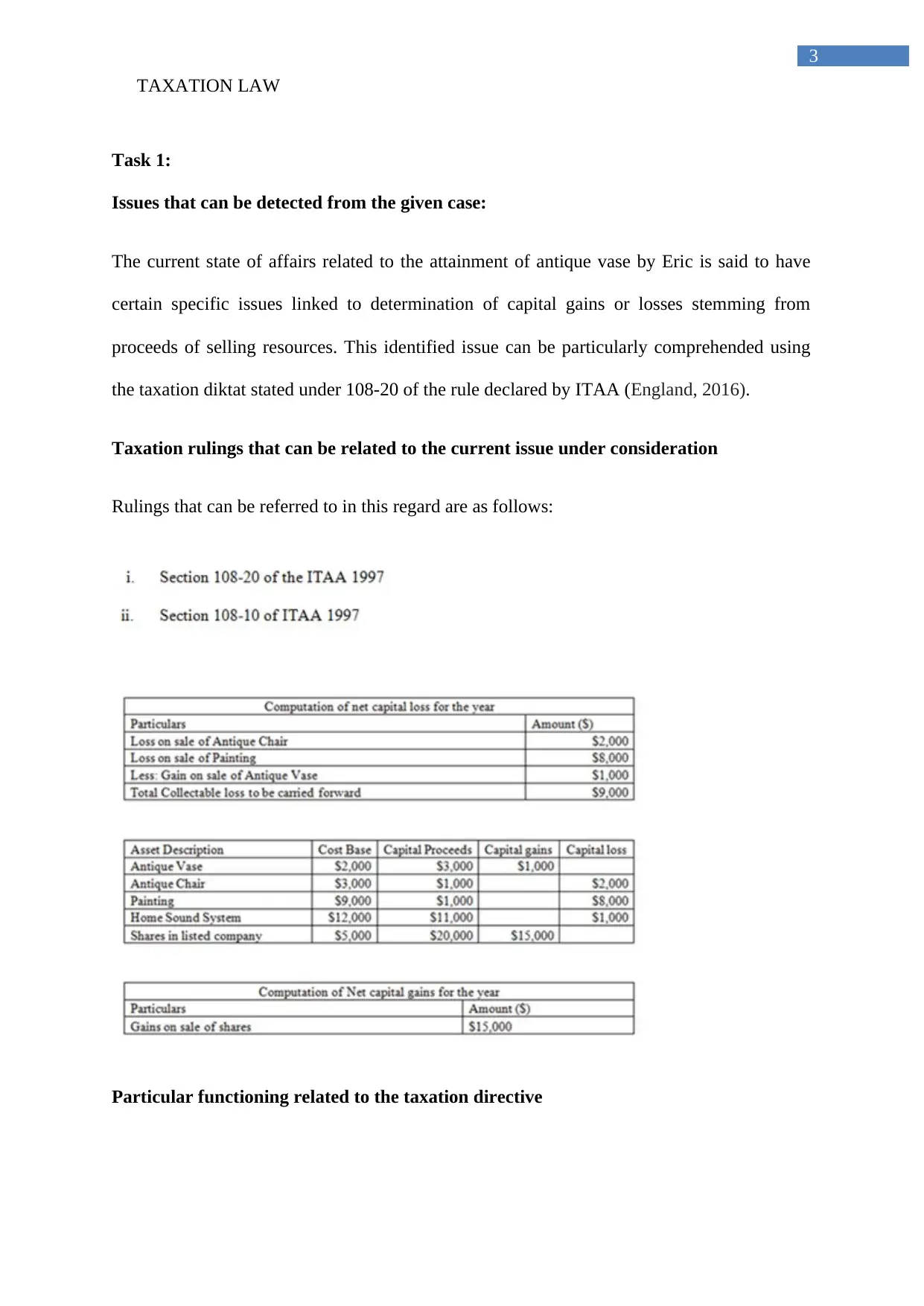
3
TAXATION LAW
Task 1:
Issues that can be detected from the given case:
The current state of affairs related to the attainment of antique vase by Eric is said to have
certain specific issues linked to determination of capital gains or losses stemming from
proceeds of selling resources. This identified issue can be particularly comprehended using
the taxation diktat stated under 108-20 of the rule declared by ITAA (England, 2016).
Taxation rulings that can be related to the current issue under consideration
Rulings that can be referred to in this regard are as follows:
Particular functioning related to the taxation directive
TAXATION LAW
Task 1:
Issues that can be detected from the given case:
The current state of affairs related to the attainment of antique vase by Eric is said to have
certain specific issues linked to determination of capital gains or losses stemming from
proceeds of selling resources. This identified issue can be particularly comprehended using
the taxation diktat stated under 108-20 of the rule declared by ITAA (England, 2016).
Taxation rulings that can be related to the current issue under consideration
Rulings that can be referred to in this regard are as follows:
Particular functioning related to the taxation directive
⊘ This is a preview!⊘
Do you want full access?
Subscribe today to unlock all pages.

Trusted by 1+ million students worldwide
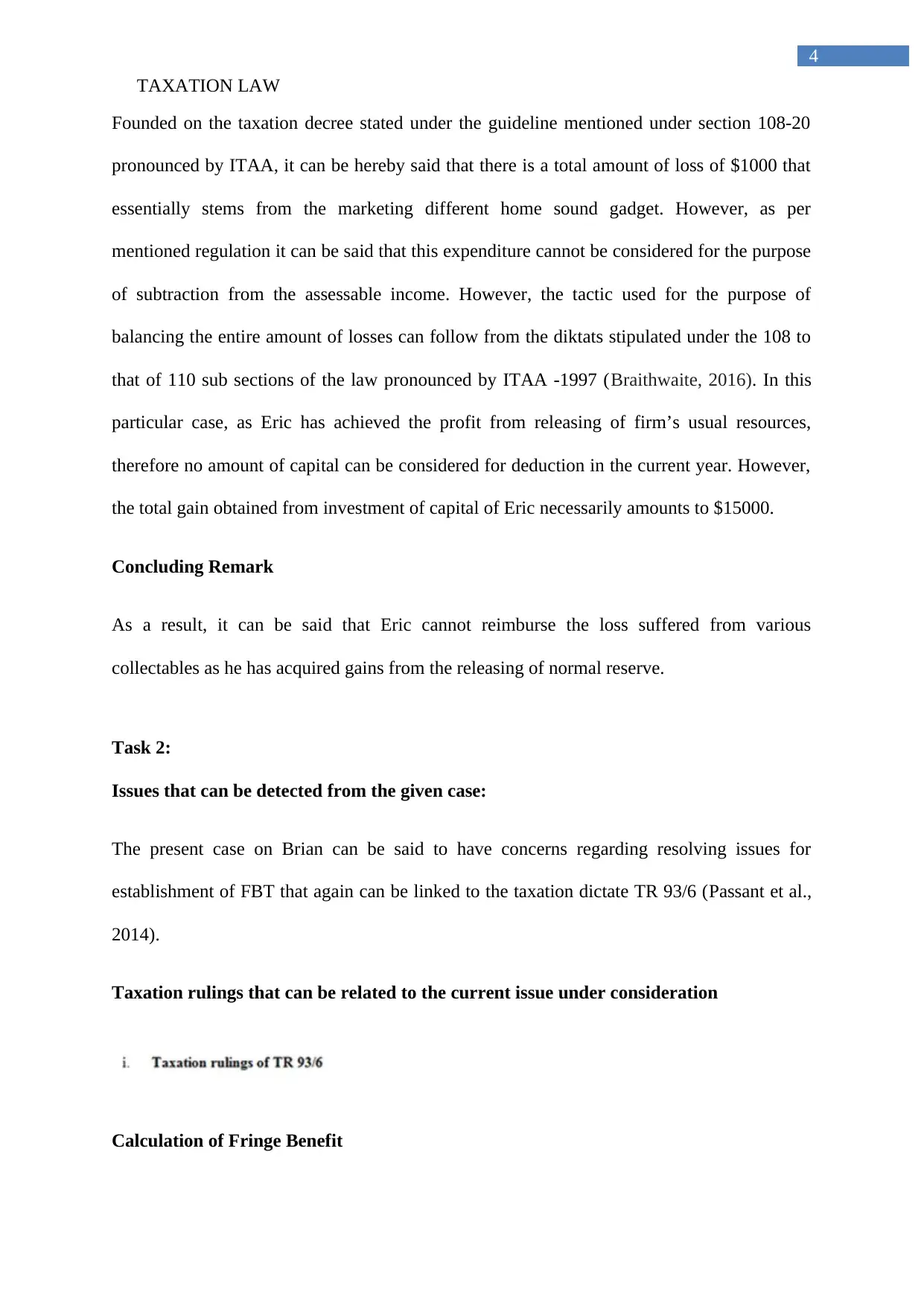
4
TAXATION LAW
Founded on the taxation decree stated under the guideline mentioned under section 108-20
pronounced by ITAA, it can be hereby said that there is a total amount of loss of $1000 that
essentially stems from the marketing different home sound gadget. However, as per
mentioned regulation it can be said that this expenditure cannot be considered for the purpose
of subtraction from the assessable income. However, the tactic used for the purpose of
balancing the entire amount of losses can follow from the diktats stipulated under the 108 to
that of 110 sub sections of the law pronounced by ITAA -1997 (Braithwaite, 2016). In this
particular case, as Eric has achieved the profit from releasing of firm’s usual resources,
therefore no amount of capital can be considered for deduction in the current year. However,
the total gain obtained from investment of capital of Eric necessarily amounts to $15000.
Concluding Remark
As a result, it can be said that Eric cannot reimburse the loss suffered from various
collectables as he has acquired gains from the releasing of normal reserve.
Task 2:
Issues that can be detected from the given case:
The present case on Brian can be said to have concerns regarding resolving issues for
establishment of FBT that again can be linked to the taxation dictate TR 93/6 (Passant et al.,
2014).
Taxation rulings that can be related to the current issue under consideration
Calculation of Fringe Benefit
TAXATION LAW
Founded on the taxation decree stated under the guideline mentioned under section 108-20
pronounced by ITAA, it can be hereby said that there is a total amount of loss of $1000 that
essentially stems from the marketing different home sound gadget. However, as per
mentioned regulation it can be said that this expenditure cannot be considered for the purpose
of subtraction from the assessable income. However, the tactic used for the purpose of
balancing the entire amount of losses can follow from the diktats stipulated under the 108 to
that of 110 sub sections of the law pronounced by ITAA -1997 (Braithwaite, 2016). In this
particular case, as Eric has achieved the profit from releasing of firm’s usual resources,
therefore no amount of capital can be considered for deduction in the current year. However,
the total gain obtained from investment of capital of Eric necessarily amounts to $15000.
Concluding Remark
As a result, it can be said that Eric cannot reimburse the loss suffered from various
collectables as he has acquired gains from the releasing of normal reserve.
Task 2:
Issues that can be detected from the given case:
The present case on Brian can be said to have concerns regarding resolving issues for
establishment of FBT that again can be linked to the taxation dictate TR 93/6 (Passant et al.,
2014).
Taxation rulings that can be related to the current issue under consideration
Calculation of Fringe Benefit
Paraphrase This Document
Need a fresh take? Get an instant paraphrase of this document with our AI Paraphraser
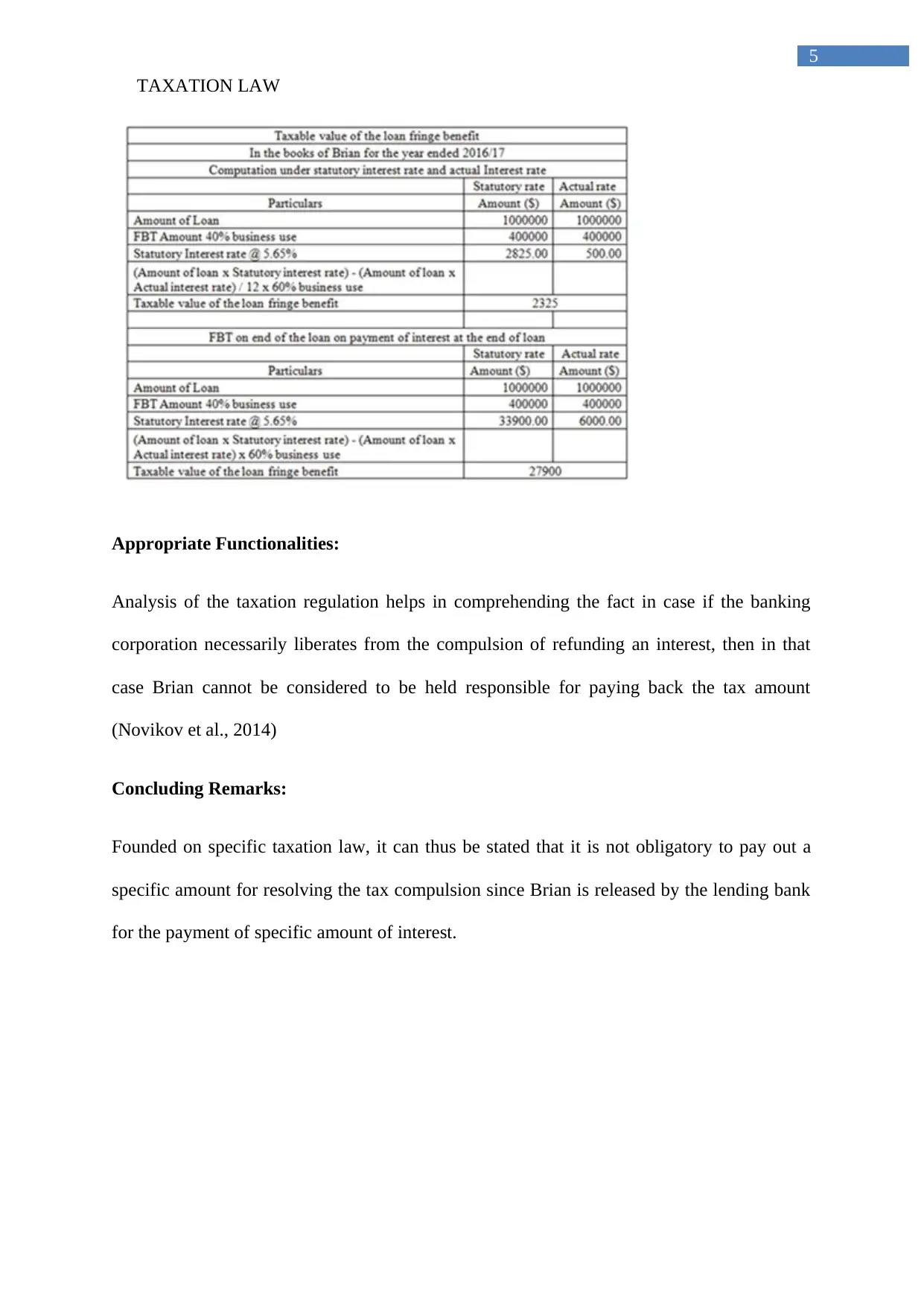
5
TAXATION LAW
Appropriate Functionalities:
Analysis of the taxation regulation helps in comprehending the fact in case if the banking
corporation necessarily liberates from the compulsion of refunding an interest, then in that
case Brian cannot be considered to be held responsible for paying back the tax amount
(Novikov et al., 2014)
Concluding Remarks:
Founded on specific taxation law, it can thus be stated that it is not obligatory to pay out a
specific amount for resolving the tax compulsion since Brian is released by the lending bank
for the payment of specific amount of interest.
TAXATION LAW
Appropriate Functionalities:
Analysis of the taxation regulation helps in comprehending the fact in case if the banking
corporation necessarily liberates from the compulsion of refunding an interest, then in that
case Brian cannot be considered to be held responsible for paying back the tax amount
(Novikov et al., 2014)
Concluding Remarks:
Founded on specific taxation law, it can thus be stated that it is not obligatory to pay out a
specific amount for resolving the tax compulsion since Brian is released by the lending bank
for the payment of specific amount of interest.
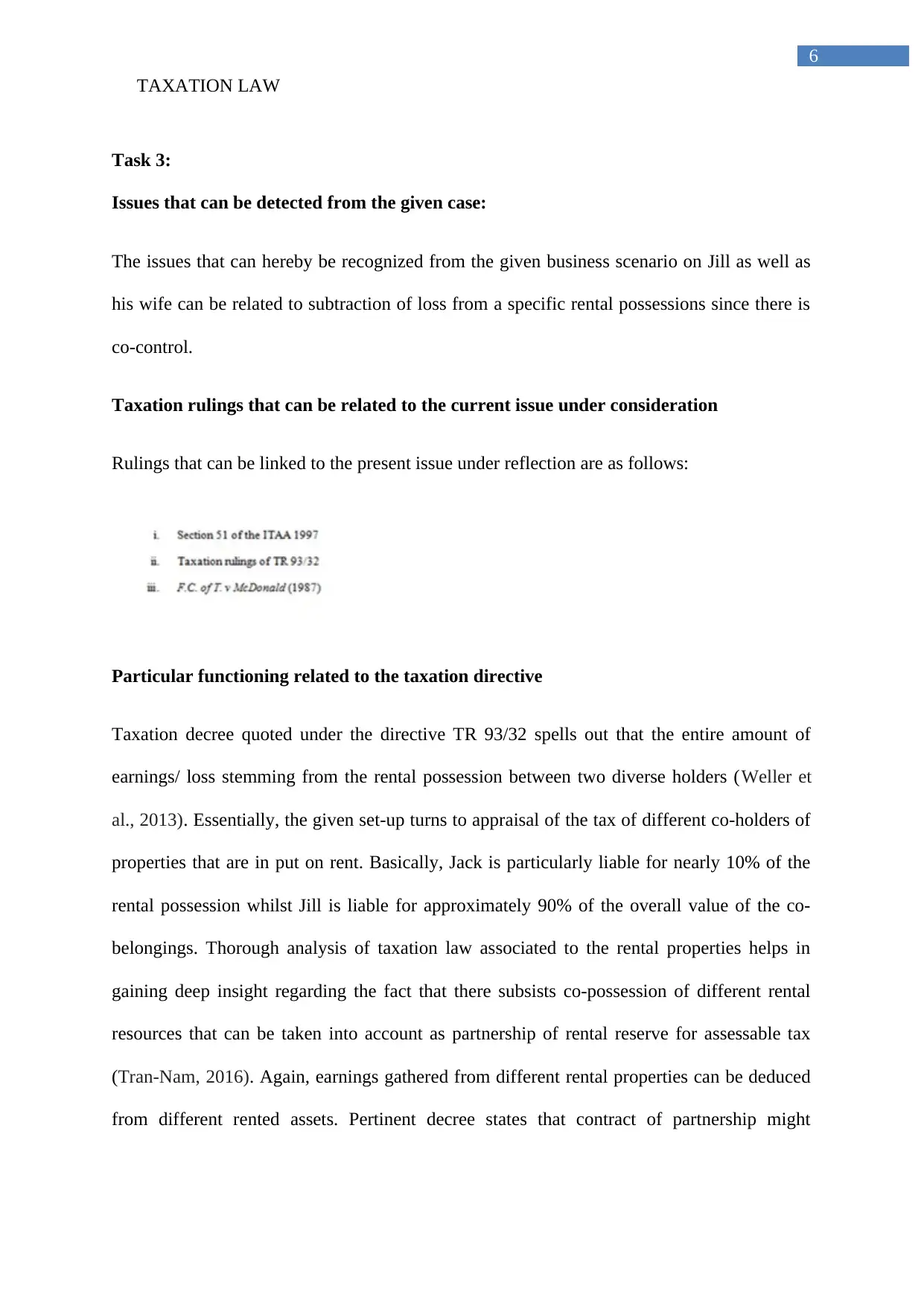
6
TAXATION LAW
Task 3:
Issues that can be detected from the given case:
The issues that can hereby be recognized from the given business scenario on Jill as well as
his wife can be related to subtraction of loss from a specific rental possessions since there is
co-control.
Taxation rulings that can be related to the current issue under consideration
Rulings that can be linked to the present issue under reflection are as follows:
Particular functioning related to the taxation directive
Taxation decree quoted under the directive TR 93/32 spells out that the entire amount of
earnings/ loss stemming from the rental possession between two diverse holders (Weller et
al., 2013). Essentially, the given set-up turns to appraisal of the tax of different co-holders of
properties that are in put on rent. Basically, Jack is particularly liable for nearly 10% of the
rental possession whilst Jill is liable for approximately 90% of the overall value of the co-
belongings. Thorough analysis of taxation law associated to the rental properties helps in
gaining deep insight regarding the fact that there subsists co-possession of different rental
resources that can be taken into account as partnership of rental reserve for assessable tax
(Tran-Nam, 2016). Again, earnings gathered from different rental properties can be deduced
from different rented assets. Pertinent decree states that contract of partnership might
TAXATION LAW
Task 3:
Issues that can be detected from the given case:
The issues that can hereby be recognized from the given business scenario on Jill as well as
his wife can be related to subtraction of loss from a specific rental possessions since there is
co-control.
Taxation rulings that can be related to the current issue under consideration
Rulings that can be linked to the present issue under reflection are as follows:
Particular functioning related to the taxation directive
Taxation decree quoted under the directive TR 93/32 spells out that the entire amount of
earnings/ loss stemming from the rental possession between two diverse holders (Weller et
al., 2013). Essentially, the given set-up turns to appraisal of the tax of different co-holders of
properties that are in put on rent. Basically, Jack is particularly liable for nearly 10% of the
rental possession whilst Jill is liable for approximately 90% of the overall value of the co-
belongings. Thorough analysis of taxation law associated to the rental properties helps in
gaining deep insight regarding the fact that there subsists co-possession of different rental
resources that can be taken into account as partnership of rental reserve for assessable tax
(Tran-Nam, 2016). Again, earnings gathered from different rental properties can be deduced
from different rented assets. Pertinent decree states that contract of partnership might
⊘ This is a preview!⊘
Do you want full access?
Subscribe today to unlock all pages.

Trusted by 1+ million students worldwide
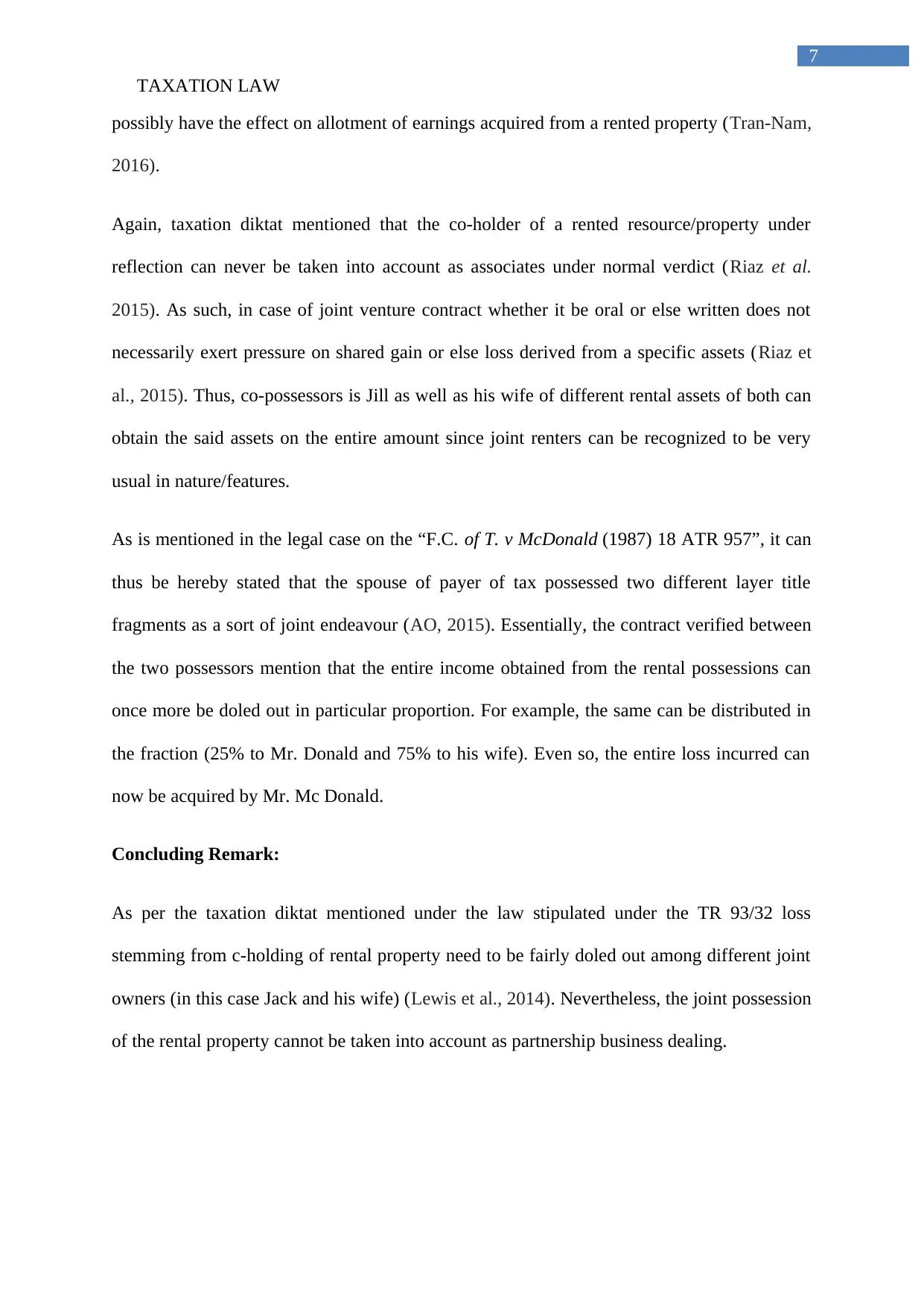
7
TAXATION LAW
possibly have the effect on allotment of earnings acquired from a rented property (Tran-Nam,
2016).
Again, taxation diktat mentioned that the co-holder of a rented resource/property under
reflection can never be taken into account as associates under normal verdict (Riaz et al.
2015). As such, in case of joint venture contract whether it be oral or else written does not
necessarily exert pressure on shared gain or else loss derived from a specific assets (Riaz et
al., 2015). Thus, co-possessors is Jill as well as his wife of different rental assets of both can
obtain the said assets on the entire amount since joint renters can be recognized to be very
usual in nature/features.
As is mentioned in the legal case on the “F.C. of T. v McDonald (1987) 18 ATR 957”, it can
thus be hereby stated that the spouse of payer of tax possessed two different layer title
fragments as a sort of joint endeavour (AO, 2015). Essentially, the contract verified between
the two possessors mention that the entire income obtained from the rental possessions can
once more be doled out in particular proportion. For example, the same can be distributed in
the fraction (25% to Mr. Donald and 75% to his wife). Even so, the entire loss incurred can
now be acquired by Mr. Mc Donald.
Concluding Remark:
As per the taxation diktat mentioned under the law stipulated under the TR 93/32 loss
stemming from c-holding of rental property need to be fairly doled out among different joint
owners (in this case Jack and his wife) (Lewis et al., 2014). Nevertheless, the joint possession
of the rental property cannot be taken into account as partnership business dealing.
TAXATION LAW
possibly have the effect on allotment of earnings acquired from a rented property (Tran-Nam,
2016).
Again, taxation diktat mentioned that the co-holder of a rented resource/property under
reflection can never be taken into account as associates under normal verdict (Riaz et al.
2015). As such, in case of joint venture contract whether it be oral or else written does not
necessarily exert pressure on shared gain or else loss derived from a specific assets (Riaz et
al., 2015). Thus, co-possessors is Jill as well as his wife of different rental assets of both can
obtain the said assets on the entire amount since joint renters can be recognized to be very
usual in nature/features.
As is mentioned in the legal case on the “F.C. of T. v McDonald (1987) 18 ATR 957”, it can
thus be hereby stated that the spouse of payer of tax possessed two different layer title
fragments as a sort of joint endeavour (AO, 2015). Essentially, the contract verified between
the two possessors mention that the entire income obtained from the rental possessions can
once more be doled out in particular proportion. For example, the same can be distributed in
the fraction (25% to Mr. Donald and 75% to his wife). Even so, the entire loss incurred can
now be acquired by Mr. Mc Donald.
Concluding Remark:
As per the taxation diktat mentioned under the law stipulated under the TR 93/32 loss
stemming from c-holding of rental property need to be fairly doled out among different joint
owners (in this case Jack and his wife) (Lewis et al., 2014). Nevertheless, the joint possession
of the rental property cannot be taken into account as partnership business dealing.
Paraphrase This Document
Need a fresh take? Get an instant paraphrase of this document with our AI Paraphraser
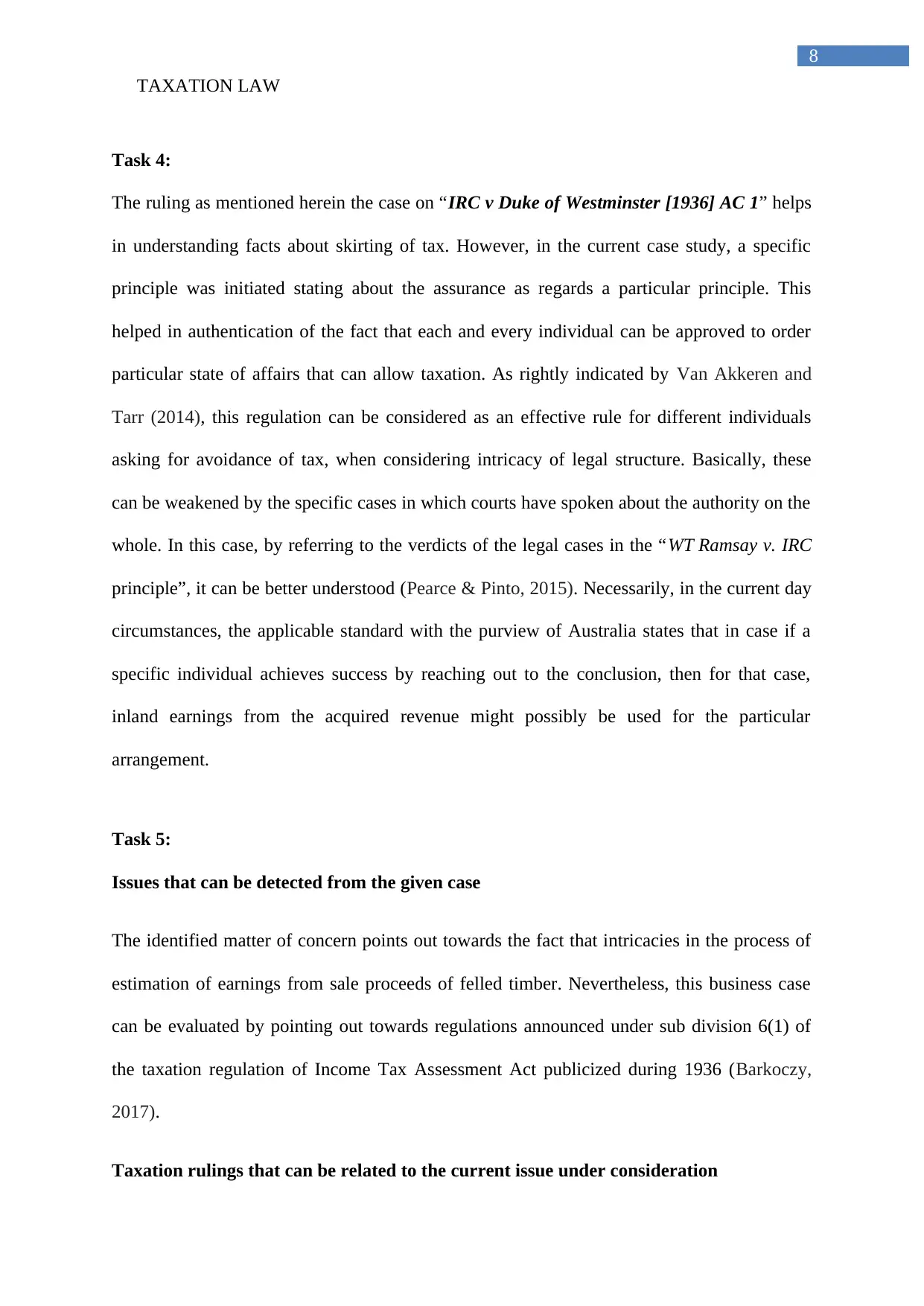
8
TAXATION LAW
Task 4:
The ruling as mentioned herein the case on “IRC v Duke of Westminster [1936] AC 1” helps
in understanding facts about skirting of tax. However, in the current case study, a specific
principle was initiated stating about the assurance as regards a particular principle. This
helped in authentication of the fact that each and every individual can be approved to order
particular state of affairs that can allow taxation. As rightly indicated by Van Akkeren and
Tarr (2014), this regulation can be considered as an effective rule for different individuals
asking for avoidance of tax, when considering intricacy of legal structure. Basically, these
can be weakened by the specific cases in which courts have spoken about the authority on the
whole. In this case, by referring to the verdicts of the legal cases in the “WT Ramsay v. IRC
principle”, it can be better understood (Pearce & Pinto, 2015). Necessarily, in the current day
circumstances, the applicable standard with the purview of Australia states that in case if a
specific individual achieves success by reaching out to the conclusion, then for that case,
inland earnings from the acquired revenue might possibly be used for the particular
arrangement.
Task 5:
Issues that can be detected from the given case
The identified matter of concern points out towards the fact that intricacies in the process of
estimation of earnings from sale proceeds of felled timber. Nevertheless, this business case
can be evaluated by pointing out towards regulations announced under sub division 6(1) of
the taxation regulation of Income Tax Assessment Act publicized during 1936 (Barkoczy,
2017).
Taxation rulings that can be related to the current issue under consideration
TAXATION LAW
Task 4:
The ruling as mentioned herein the case on “IRC v Duke of Westminster [1936] AC 1” helps
in understanding facts about skirting of tax. However, in the current case study, a specific
principle was initiated stating about the assurance as regards a particular principle. This
helped in authentication of the fact that each and every individual can be approved to order
particular state of affairs that can allow taxation. As rightly indicated by Van Akkeren and
Tarr (2014), this regulation can be considered as an effective rule for different individuals
asking for avoidance of tax, when considering intricacy of legal structure. Basically, these
can be weakened by the specific cases in which courts have spoken about the authority on the
whole. In this case, by referring to the verdicts of the legal cases in the “WT Ramsay v. IRC
principle”, it can be better understood (Pearce & Pinto, 2015). Necessarily, in the current day
circumstances, the applicable standard with the purview of Australia states that in case if a
specific individual achieves success by reaching out to the conclusion, then for that case,
inland earnings from the acquired revenue might possibly be used for the particular
arrangement.
Task 5:
Issues that can be detected from the given case
The identified matter of concern points out towards the fact that intricacies in the process of
estimation of earnings from sale proceeds of felled timber. Nevertheless, this business case
can be evaluated by pointing out towards regulations announced under sub division 6(1) of
the taxation regulation of Income Tax Assessment Act publicized during 1936 (Barkoczy,
2017).
Taxation rulings that can be related to the current issue under consideration
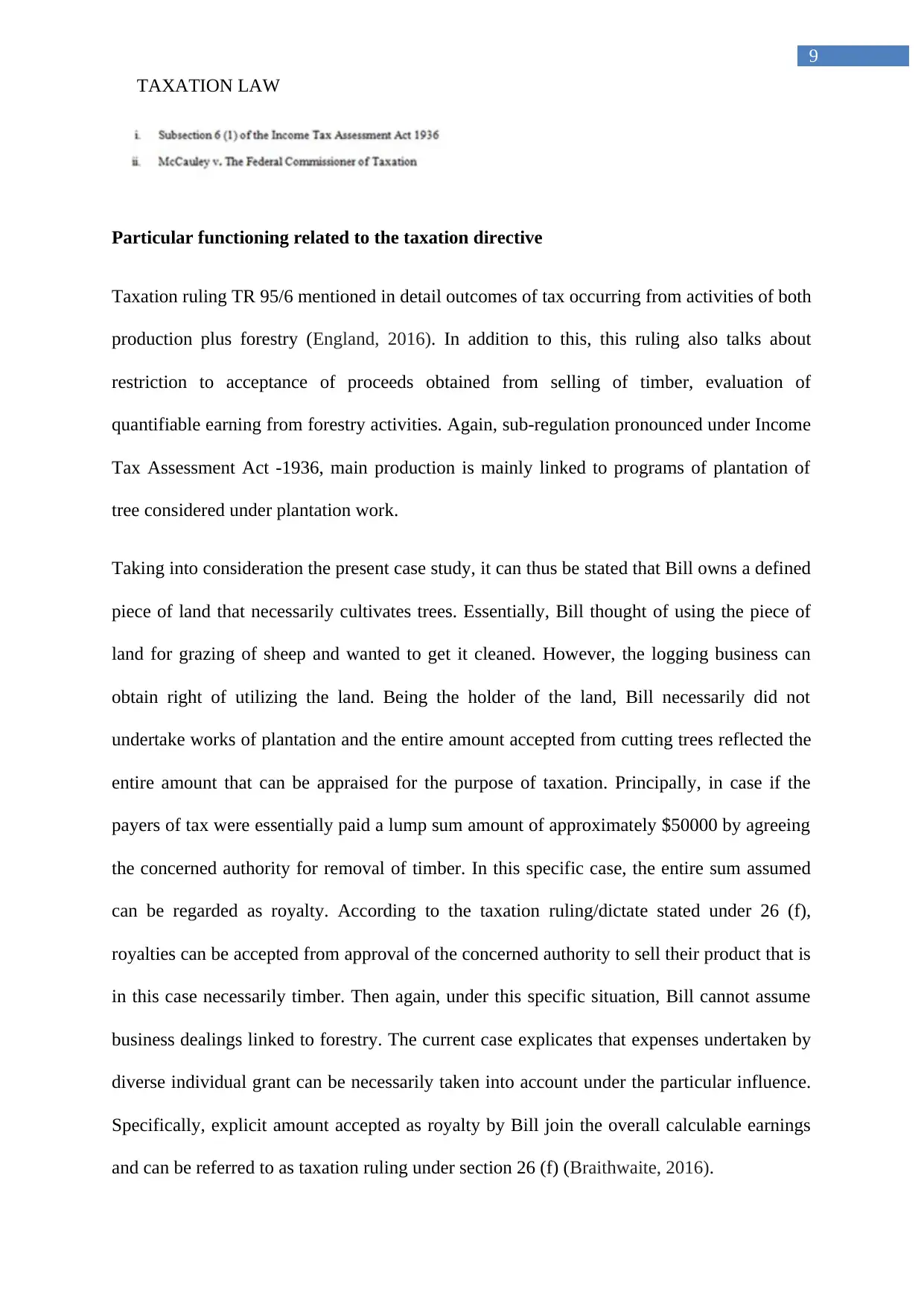
9
TAXATION LAW
Particular functioning related to the taxation directive
Taxation ruling TR 95/6 mentioned in detail outcomes of tax occurring from activities of both
production plus forestry (England, 2016). In addition to this, this ruling also talks about
restriction to acceptance of proceeds obtained from selling of timber, evaluation of
quantifiable earning from forestry activities. Again, sub-regulation pronounced under Income
Tax Assessment Act -1936, main production is mainly linked to programs of plantation of
tree considered under plantation work.
Taking into consideration the present case study, it can thus be stated that Bill owns a defined
piece of land that necessarily cultivates trees. Essentially, Bill thought of using the piece of
land for grazing of sheep and wanted to get it cleaned. However, the logging business can
obtain right of utilizing the land. Being the holder of the land, Bill necessarily did not
undertake works of plantation and the entire amount accepted from cutting trees reflected the
entire amount that can be appraised for the purpose of taxation. Principally, in case if the
payers of tax were essentially paid a lump sum amount of approximately $50000 by agreeing
the concerned authority for removal of timber. In this specific case, the entire sum assumed
can be regarded as royalty. According to the taxation ruling/dictate stated under 26 (f),
royalties can be accepted from approval of the concerned authority to sell their product that is
in this case necessarily timber. Then again, under this specific situation, Bill cannot assume
business dealings linked to forestry. The current case explicates that expenses undertaken by
diverse individual grant can be necessarily taken into account under the particular influence.
Specifically, explicit amount accepted as royalty by Bill join the overall calculable earnings
and can be referred to as taxation ruling under section 26 (f) (Braithwaite, 2016).
TAXATION LAW
Particular functioning related to the taxation directive
Taxation ruling TR 95/6 mentioned in detail outcomes of tax occurring from activities of both
production plus forestry (England, 2016). In addition to this, this ruling also talks about
restriction to acceptance of proceeds obtained from selling of timber, evaluation of
quantifiable earning from forestry activities. Again, sub-regulation pronounced under Income
Tax Assessment Act -1936, main production is mainly linked to programs of plantation of
tree considered under plantation work.
Taking into consideration the present case study, it can thus be stated that Bill owns a defined
piece of land that necessarily cultivates trees. Essentially, Bill thought of using the piece of
land for grazing of sheep and wanted to get it cleaned. However, the logging business can
obtain right of utilizing the land. Being the holder of the land, Bill necessarily did not
undertake works of plantation and the entire amount accepted from cutting trees reflected the
entire amount that can be appraised for the purpose of taxation. Principally, in case if the
payers of tax were essentially paid a lump sum amount of approximately $50000 by agreeing
the concerned authority for removal of timber. In this specific case, the entire sum assumed
can be regarded as royalty. According to the taxation ruling/dictate stated under 26 (f),
royalties can be accepted from approval of the concerned authority to sell their product that is
in this case necessarily timber. Then again, under this specific situation, Bill cannot assume
business dealings linked to forestry. The current case explicates that expenses undertaken by
diverse individual grant can be necessarily taken into account under the particular influence.
Specifically, explicit amount accepted as royalty by Bill join the overall calculable earnings
and can be referred to as taxation ruling under section 26 (f) (Braithwaite, 2016).
⊘ This is a preview!⊘
Do you want full access?
Subscribe today to unlock all pages.

Trusted by 1+ million students worldwide

10
TAXATION LAW
Concluding Remark
In conclusion it can be hereby stated that recognizing receipt as earnings from marketing
felled trees can be taken into account as taxable earning. This can be particularly considered
under ruling sub-division 6(1) of tax decree of ITAA pronounced in 1997.
TAXATION LAW
Concluding Remark
In conclusion it can be hereby stated that recognizing receipt as earnings from marketing
felled trees can be taken into account as taxable earning. This can be particularly considered
under ruling sub-division 6(1) of tax decree of ITAA pronounced in 1997.
Paraphrase This Document
Need a fresh take? Get an instant paraphrase of this document with our AI Paraphraser
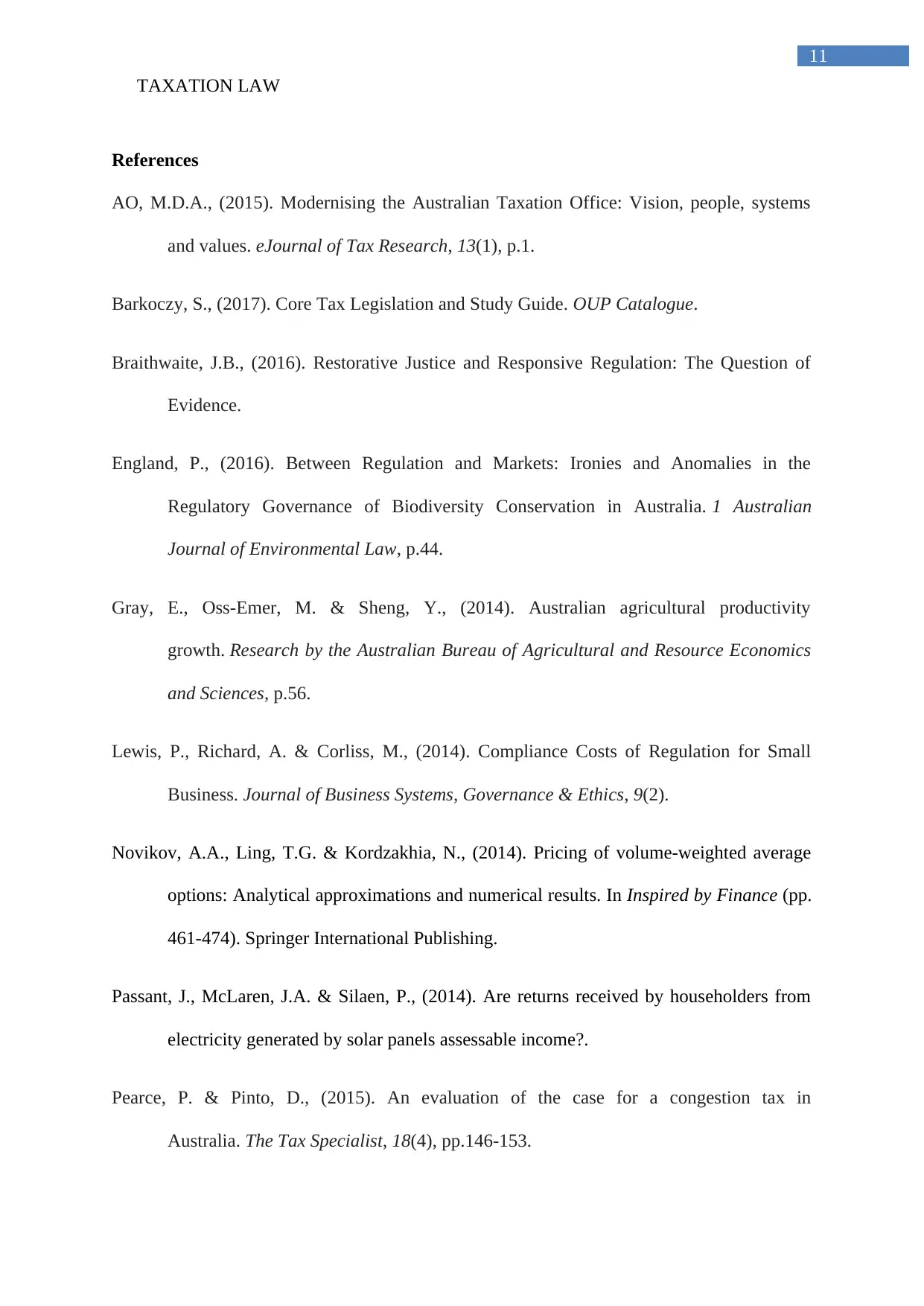
11
TAXATION LAW
References
AO, M.D.A., (2015). Modernising the Australian Taxation Office: Vision, people, systems
and values. eJournal of Tax Research, 13(1), p.1.
Barkoczy, S., (2017). Core Tax Legislation and Study Guide. OUP Catalogue.
Braithwaite, J.B., (2016). Restorative Justice and Responsive Regulation: The Question of
Evidence.
England, P., (2016). Between Regulation and Markets: Ironies and Anomalies in the
Regulatory Governance of Biodiversity Conservation in Australia. 1 Australian
Journal of Environmental Law, p.44.
Gray, E., Oss-Emer, M. & Sheng, Y., (2014). Australian agricultural productivity
growth. Research by the Australian Bureau of Agricultural and Resource Economics
and Sciences, p.56.
Lewis, P., Richard, A. & Corliss, M., (2014). Compliance Costs of Regulation for Small
Business. Journal of Business Systems, Governance & Ethics, 9(2).
Novikov, A.A., Ling, T.G. & Kordzakhia, N., (2014). Pricing of volume-weighted average
options: Analytical approximations and numerical results. In Inspired by Finance (pp.
461-474). Springer International Publishing.
Passant, J., McLaren, J.A. & Silaen, P., (2014). Are returns received by householders from
electricity generated by solar panels assessable income?.
Pearce, P. & Pinto, D., (2015). An evaluation of the case for a congestion tax in
Australia. The Tax Specialist, 18(4), pp.146-153.
TAXATION LAW
References
AO, M.D.A., (2015). Modernising the Australian Taxation Office: Vision, people, systems
and values. eJournal of Tax Research, 13(1), p.1.
Barkoczy, S., (2017). Core Tax Legislation and Study Guide. OUP Catalogue.
Braithwaite, J.B., (2016). Restorative Justice and Responsive Regulation: The Question of
Evidence.
England, P., (2016). Between Regulation and Markets: Ironies and Anomalies in the
Regulatory Governance of Biodiversity Conservation in Australia. 1 Australian
Journal of Environmental Law, p.44.
Gray, E., Oss-Emer, M. & Sheng, Y., (2014). Australian agricultural productivity
growth. Research by the Australian Bureau of Agricultural and Resource Economics
and Sciences, p.56.
Lewis, P., Richard, A. & Corliss, M., (2014). Compliance Costs of Regulation for Small
Business. Journal of Business Systems, Governance & Ethics, 9(2).
Novikov, A.A., Ling, T.G. & Kordzakhia, N., (2014). Pricing of volume-weighted average
options: Analytical approximations and numerical results. In Inspired by Finance (pp.
461-474). Springer International Publishing.
Passant, J., McLaren, J.A. & Silaen, P., (2014). Are returns received by householders from
electricity generated by solar panels assessable income?.
Pearce, P. & Pinto, D., (2015). An evaluation of the case for a congestion tax in
Australia. The Tax Specialist, 18(4), pp.146-153.
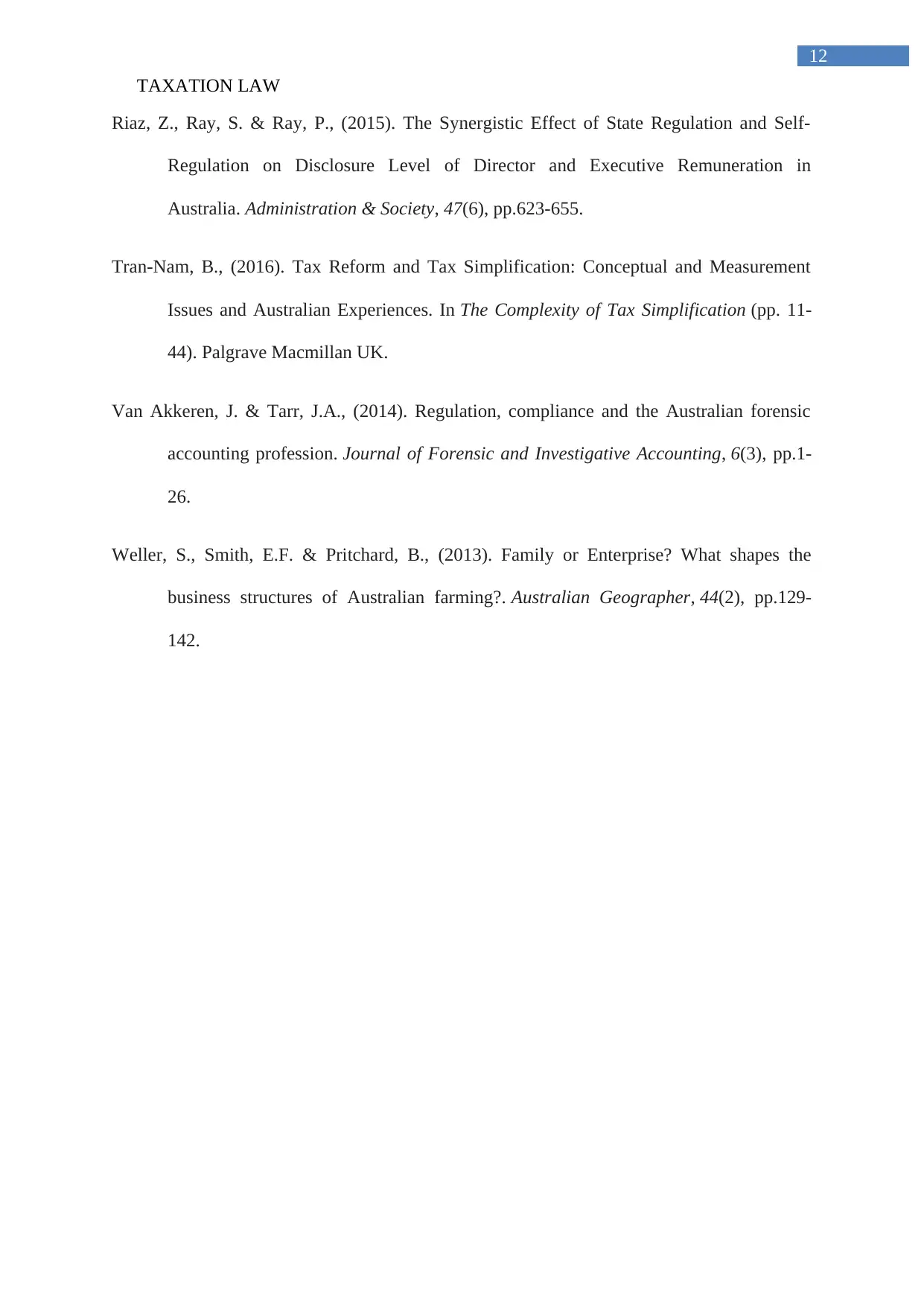
12
TAXATION LAW
Riaz, Z., Ray, S. & Ray, P., (2015). The Synergistic Effect of State Regulation and Self-
Regulation on Disclosure Level of Director and Executive Remuneration in
Australia. Administration & Society, 47(6), pp.623-655.
Tran-Nam, B., (2016). Tax Reform and Tax Simplification: Conceptual and Measurement
Issues and Australian Experiences. In The Complexity of Tax Simplification (pp. 11-
44). Palgrave Macmillan UK.
Van Akkeren, J. & Tarr, J.A., (2014). Regulation, compliance and the Australian forensic
accounting profession. Journal of Forensic and Investigative Accounting, 6(3), pp.1-
26.
Weller, S., Smith, E.F. & Pritchard, B., (2013). Family or Enterprise? What shapes the
business structures of Australian farming?. Australian Geographer, 44(2), pp.129-
142.
TAXATION LAW
Riaz, Z., Ray, S. & Ray, P., (2015). The Synergistic Effect of State Regulation and Self-
Regulation on Disclosure Level of Director and Executive Remuneration in
Australia. Administration & Society, 47(6), pp.623-655.
Tran-Nam, B., (2016). Tax Reform and Tax Simplification: Conceptual and Measurement
Issues and Australian Experiences. In The Complexity of Tax Simplification (pp. 11-
44). Palgrave Macmillan UK.
Van Akkeren, J. & Tarr, J.A., (2014). Regulation, compliance and the Australian forensic
accounting profession. Journal of Forensic and Investigative Accounting, 6(3), pp.1-
26.
Weller, S., Smith, E.F. & Pritchard, B., (2013). Family or Enterprise? What shapes the
business structures of Australian farming?. Australian Geographer, 44(2), pp.129-
142.
⊘ This is a preview!⊘
Do you want full access?
Subscribe today to unlock all pages.

Trusted by 1+ million students worldwide
1 out of 12
Related Documents
Your All-in-One AI-Powered Toolkit for Academic Success.
+13062052269
info@desklib.com
Available 24*7 on WhatsApp / Email
![[object Object]](/_next/static/media/star-bottom.7253800d.svg)
Unlock your academic potential
Copyright © 2020–2025 A2Z Services. All Rights Reserved. Developed and managed by ZUCOL.





